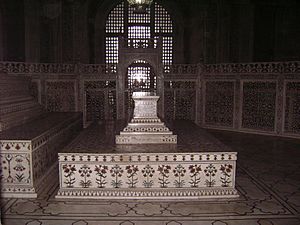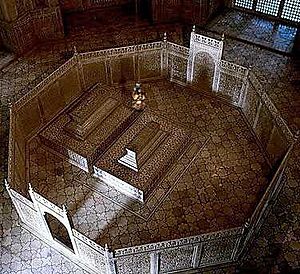Mumtaz Mahal facts for kids
Quick facts for kids Mumtaz Mahal |
|
|---|---|
| Empress consort of the Mughal Empire | |
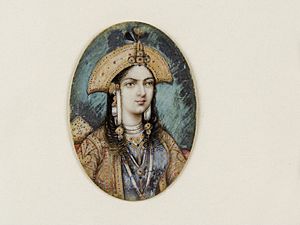
Portrait of Mumtaz Mahal on Ivory. 17th-century. Lahore Museum
|
|
| Padshah Begum | |
| Tenure | 19 January 1628 – 17 June 1631 |
| Predecessor | Nur Jahan |
| Successor | Jahanara Begum |
| Born | Arjumand Banu Begum 29 October 1593 Agra, Mughal Empire |
| Died | 17 June 1631 (aged 38) Burhanpur, Mughal Empire |
| Burial | Taj Mahal, Agra |
| Spouse | |
| Issue among others... |
|
| House | Timurid (by marriage) |
| Father | Abu'l-Hasan Asaf Khan |
| Mother | Diwanji Begum |
Mumtaz Mahal (born Arjumand Banu Begum; 29 October 1593 – 17 June 1631) was a powerful empress of the Mughal Empire. She was the main wife of the fifth Mughal emperor, Shah Jahan.
Mumtaz Mahal is famous because her husband built the amazing Taj Mahal in Agra as her tomb. Many people call the Taj Mahal one of the Wonders of the World.
She was born in Agra to a rich Persian noble family. Her father, Abu'l-Hasan Asaf Khan, held an important position in the Mughal Empire. Her aunt was Empress Nur Jahan, who was a very influential wife of Emperor Jahangir.
Mumtaz Mahal married Prince Khurram (later Shah Jahan) in 1612 when she was 19. He gave her the special name "Mumtaz Mahal," which means "the exalted one of the Palace." They had 14 children together.
She died in 1631 in Burhanpur while giving birth to her 14th child. Shah Jahan was heartbroken and ordered the building of the Taj Mahal to honor her.
Contents
Her Family and Early Life
Mumtaz Mahal was born Arjumand Banu on 29 October 1593 in Agra. Her father, Abu'l-Hasan Asaf Khan, was a very wealthy Persian noble. He held a high position in the Mughal Empire. Her mother was Diwanji Begum.
Her family came to India in 1577. Her grandfather, Mirza Ghias Beg, started working for Emperor Akbar in Agra.
Mumtaz Mahal's aunt was Empress Nur Jahan. Nur Jahan was the main wife of Emperor Jahangir, who was Shah Jahan's father. This made Mumtaz Mahal Nur Jahan's niece and later, her step daughter-in-law.
Mumtaz was a very smart and talented lady. She knew Arabic and Persian languages well. She could even write poems in Persian. People said she was modest but also very direct and confident. Even when she was young, important nobles noticed her. Emperor Jahangir agreed to her engagement with Shah Jahan easily.
Her Marriage to Shah Jahan
Mumtaz Mahal was engaged to Shah Jahan around 1607. She was 14 years old, and he was 15. However, they married five years later, on 10 May 1612, in Agra.
After their wedding, Shah Jahan was very impressed by her. He gave her the title Mumtaz Mahal, meaning "the exalted one of the Palace."
Shah Jahan had married another wife before Mumtaz and took a third wife later. But official historians say these other marriages were for political reasons. Shah Jahan loved Mumtaz Mahal the most. He showed little interest in his other wives.
One historian, Motamid Khan, wrote that Shah Jahan's love for Mumtaz was far greater than for his other wives. Another historian, Inayat Khan, said Shah Jahan's "whole delight was centered on this illustrious lady."
Mumtaz and Shah Jahan had a very loving marriage. Poets even wrote about her beauty and kindness during her lifetime. Even though she was often pregnant, Mumtaz traveled with Shah Jahan during his military trips. In their 19 years of marriage, they had 14 children. Seven of their children died when they were very young.
Empress of the Mughal Empire
When Shah Jahan became emperor in 1628, he made Mumtaz his chief empress. He gave her important titles like 'Padshah Begum' (First Lady or Queen of the Great). He also called her 'Queen of the World' and 'Queen of the Age'.
Mumtaz was empress for only three years because she died young. But Shah Jahan gave her many grand luxuries. She was the only wife of Shah Jahan called "Hazrat," because she was the mother of the future emperor.
Her home, Khas Mahal in Agra Fort, was decorated with pure gold and precious stones. It even had rose-water fountains. Mumtaz Mahal also received a huge monthly allowance of one million rupees per year. She also owned many valuable lands and properties.
Shah Jahan often asked Mumtaz for advice on both family matters and state affairs. She was his trusted friend and adviser. Because of this, she had a lot of political power. She could ask him to forgive enemies or change death sentences.
Shah Jahan trusted her so much that he gave her his imperial seal, the Mehr Uzaz. This seal was needed to approve imperial orders. Nothing could be done without her agreement. Unlike her aunt, Empress Nur Jahan, Mumtaz was not interested in gaining political power for herself.
Mumtaz Mahal was a great influence on Shah Jahan. She often helped poor and needy people. She also enjoyed watching elephant fights and combat shows at court. Mumtaz also supported many poets, scholars, and talented people. She even gave money to the daughters of poor scholars and religious men. She also helped build a garden by the river in Agra, now called Zahara Bagh.
Her Death and What Happened Next

Mumtaz Mahal died in Burhanpur on 17 June 1631. She died after giving birth to her 14th child, a daughter named Gauhar Ara Begum. She had been with her husband during a military trip.
Her body was first buried in a garden in Burhanpur. Court writers at the time wrote a lot about Mumtaz Mahal's death. They also wrote about Shah Jahan's deep sadness. He was reportedly inconsolable after she died. He went into mourning for a whole year. When he appeared again, his hair had turned white, and he looked much older.
Mumtaz's oldest daughter, Jahanara Begum, helped her father recover from his grief. She then took her mother's place at court.
Shah Jahan divided Mumtaz Mahal's personal wealth (worth 10 million rupees). Jahanara Begum received half, and the rest went to her other children.
Shah Jahan did not want Burhanpur to be his wife's final resting place. So, in December 1631, her body was moved in a golden box. It was taken back to Agra, guarded by her son Shah Shuja and other important people. She was buried in a small building by the Yamuna River.
Shah Jahan stayed in Burhanpur to finish his military campaign. While there, he started planning a grand tomb and garden for his wife in Agra. This project took 22 years to complete and became the famous Taj Mahal.
The Taj Mahal
The Taj Mahal was built by Shah Jahan as a mausoleum (a grand tomb) for Mumtaz Mahal. It is seen as a symbol of never-ending love. The English poet Sir Edwin Arnold called it "Not a piece of architecture... but the proud passion of an emperor's love wrought in living stones."
The beauty of the Taj Mahal is often compared to Mumtaz Mahal's beauty. This makes many people describe the Taj Mahal as having a feminine grace.
Muslim tradition does not allow fancy decorations on graves. So, the actual bodies of Mumtaz and Shah Jahan are in a simple crypt below the main room. Their faces are turned towards Mecca.
The Ninety-Nine Names of God are written in beautiful calligraphy on the sides of Mumtaz Mahal's tomb. These include names like "O Noble, O Magnificent, O Majestic."
There are many ideas about where the name 'Taj Mahal' came from. One idea is that 'Taj' is a short form of Mumtaz. European travelers who saw it being built were among the first to call it the Taj Mahal. They might have heard locals in Agra call the Empress 'Taj Mahal'. They might have thought the tomb was named after her.
Shah Jahan did not plan to bury anyone else in the Taj Mahal. However, his son Aurangzeb buried Shah Jahan next to Mumtaz Mahal's tomb. This is why Shah Jahan's grave is not in the exact center, but slightly to one side of his wife's.
Her Children
| Name | Portrait | Lifespan | Notes |
|---|---|---|---|
| Hur-ul-Nisa Begum |
30 March 1613 – 5 June 1616 |
Died young from smallpox at age 3. | |
| Jahanara Begum Padshah Begum |
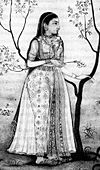 |
23 March 1614 – 16 September 1681 |
Shah Jahan's favorite and most important daughter. She became the First Lady of the Mughal Empire after her mother died. She never married. |
| Dara Shikoh Crown Prince |
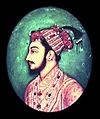 |
20 March 1615 – 30 August 1659 |
The oldest son and heir to the throne. His father, Shah Jahan, wanted him to be the next emperor. But his younger brother, Aurangzeb, defeated and killed him in a fight for the throne. He married and had children. |
| Shah Shuja |
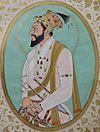 |
23 June 1616 – 7 February 1661 |
He was involved in the fight for the throne. He married and had children. |
| Roshanara Begum Padshah Begum |
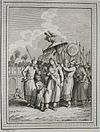 |
3 September 1617 – 11 September 1671 |
She was an important daughter of Shah Jahan and supported Aurangzeb in the fight for the throne. She never married. |
| Aurangzeb Mughal emperor |
 |
3 November 1618 – 3 March 1707 |
He became the sixth Mughal emperor. He won the fight for the throne after his father, Shah Jahan, became ill. He married and had children. |
| Izad Bakhsh |
18 December 1619 – February/March 1621 |
Died as a baby. | |
| Surayya Banu Begum |
10 June 1621 – 28 April 1628 |
Died young from smallpox at age 7. | |
| Unnamed son |
1622 | Died soon after birth. | |
| Murad Bakhsh |
 |
8 October 1624 – 14 December 1661 |
He was executed in 1661 by Aurangzeb's orders. He married and had children. |
| Lutf Allah |
4 November 1626 – 13 May 1628 |
Died at one and a half years old. | |
| Daulat Afza |
8 May 1628 – 13 May 1629 |
Died as a baby. | |
| Husn Ara Begum |
23 April 1630 – 1631 |
Died as a baby. | |
| Gauhar Ara Begum |
17 June 1631 – 1706 |
Mumtaz died while giving birth to her. She never married. |
See also
 In Spanish: Mumtaz Mahal para niños
In Spanish: Mumtaz Mahal para niños


